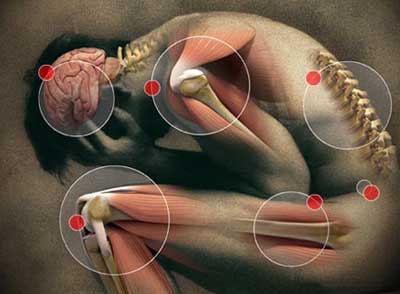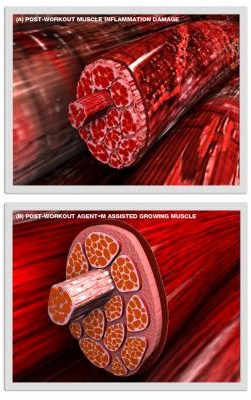Soreness
Owie. How about those stairs? Washing your hair? Fun stuff after some brutal workouts.
Being sore, medically known as DOMS (Delayed onset muscle soreness) is that pain and stiffness felt in muscles several hours to days after exercise. Especially after unaccustomed or strenuous work. Soreness is felt most strongly 24 to 72 hours after exercise. We all know how two days post-workout can actually be tougher than the next day. Soreness is most commonly caused by eccentric exercise, which is any "negative" action of the muscles-- basically being under stress while contracting or resisting movement.
We also know that after this stress the muscle adapts rapidly in an effort to prevent future muscle damage if a given movement is repeated. This is where recovery in the sense of nutrition and sleep play so valuable of a role.
But in the meanwhile, what to do about that soreness?
First, let everyone realize it's okay to work sore muscles. However, you need to be the person deciding if the muscle will be further damaged with more exercise, to the point that it would be unhealthy. As in, overtraining. Two days in a row of squats may counter what was previously taught in terms of variance, but we need to realize that "real life" often calls on us to use the same muscle groups two or more days in a row... even every single day of life. In an emergency situation, the joke is always, "Oh, I can't help save that person's life right now by helping to lift that heavy item off their body because I just did legs yesterday at the gym. Sorry." Ridiculous, right?
So if we get down to the research on off-setting muscle soreness, the leading advice for years has been to reduce inflammation. In basic terms, ice. Anti-inflammatory medication has been an option more recently, specifically with the following:
- NSAIDs (nonsteroidal anti-inflammatory drugs). These include aspirin, ibuprofen (Advil and Motrin), naproxen sodium (Aleve), and ketoprofen (Orudis KT).
- Acetaminophen (Tylenol and Panadol).
There are of course other health risks researched and associated with use of these meds, as seen in quick terms on the website linked above. Use of naproxen sodium in short periods of time and in the smallest quantity possible is quick and reliable and a recommendation if the muscle soreness is just too much to overcome on a given day. I am not a doctor and by no means is this a daily prescription. The opposite, actually.
Daily use of natural anti-inflammatory foods has become widely accepted in terms of supplementing Fish Oil or Krill Oil. It is proven that the omega-3 fatty acids are utilized in the building material for prostaglandins. According to research, when prostaglandins are made they work in an efficient manner in their "healing" effects with less risk of the inflammatory damage from above medication.
Just recently Physio Tape has received a lot of use. It increases blood circulation to the taped area, also numbing the area to allow less fatigue. People who use it love the immediate benefits, although it doesn't seem to do much in terms of DOMS.
Compression Gear has also been marketed to help improve blood flow during workouts and cut down on muscle soreness. See Helpful or Hurtful? for runners or Do compression clothes really impact sport performance? just to cite a few.
There are also Sportscreams and gels that can be used (namely Bengay, Biofreeze, and the like). The goal is to bring more blood flow to the area in attempts to break up inflammation and trigger cell growth and tissue repair. They get no endorsement from me, for what it's worth, since your body can do the same thing through active recovery.
"Active Recovery" has been promoted recently instead of icing; the use of movement to stimulate repair lets the body do it's inherent job after a stressful workout or competition has been experienced. This is actually fairly controversial and I look forward to more research and debate surrounding this concept. The idea is mobilize and self-massage to aide in recovery. Proponents included in the video below are advocates for letting the body do its job by protecting the stressed muscles and connective tissue and then rejuvenating cells in the reconstructive stage of recovery.
People, we've got to stop icing Read more here.
So what gets the stamp of approval? Well, keeping up with the research, I suppose. We don't have the exact answer since we're in the same boat as everyone else-- hoping that the medical and exercise physiologist community can do their jobs in providing the public with constant, accurate information.
Recommendations (For Now):
1. Icing It seems that the word is still out on the subject of ice: To ice, or not to ice? That is the question. Does it work for you? Have at it. Think you can clear up the soreness with mobility? Perhaps even better.

2. Foam Rollers Massage therapy for before and after workouts, foam rollers are like a sports massage without the high price tag. Rolling out increases circulation, breaks down soft tissue adhesion, and provides myofascial release. Google it.
3. Lacrosse Balls Used as a mobility tool, it can hit deep into the trigger points like a foam roller on steroids. Try it, you'll be pleasantly in pain.

4. Medication Use anti-inflammatory meds as a last resort. Naproxen sodium (Aleve), one to two tablets. Give it a day, maybe two doses 6-8 hours apart, and that should be just fine. Anything over that and there's more going on there than simple DOMS.

Now, off to recovery you go. Just go easy on the stairs.
-Scott, 9.17.2012

